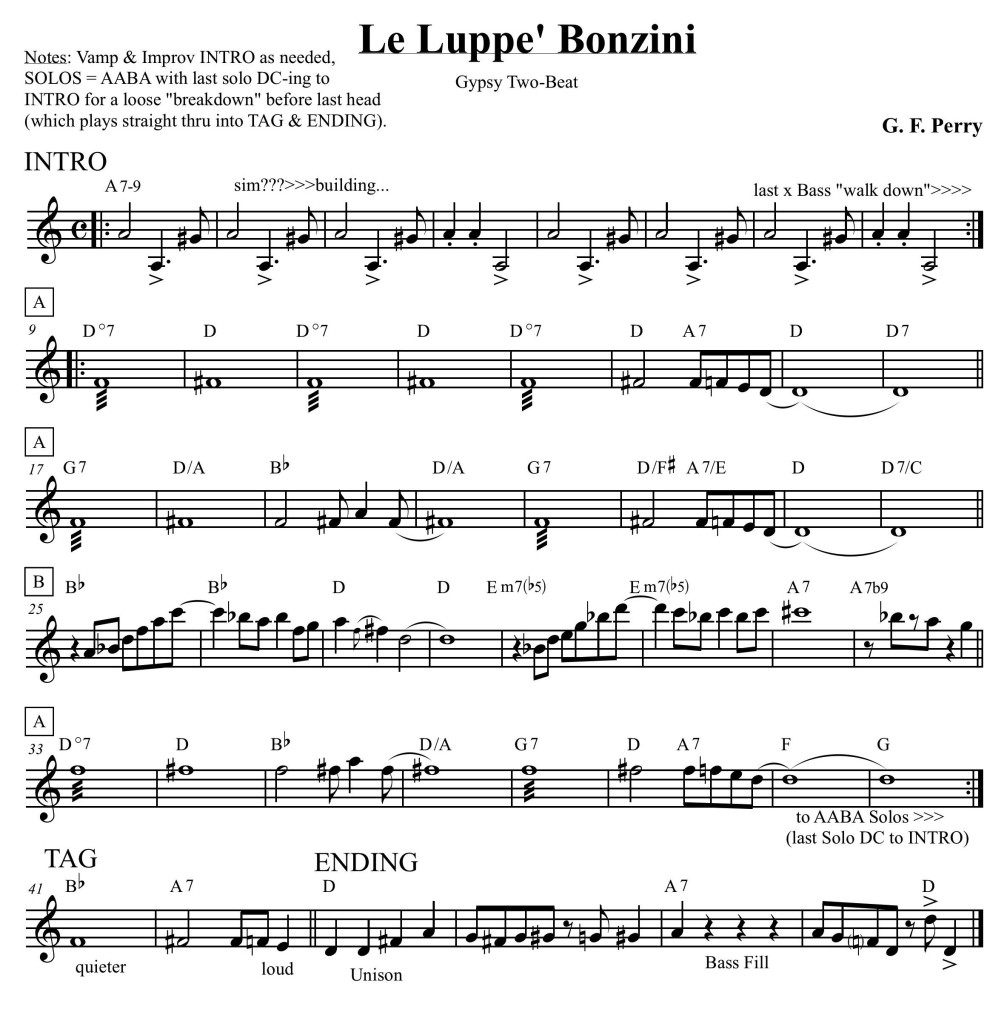Description: A Geoff Perry original that first appeared on Babik’s “American Gypsy” CD. The melody features tremolo and some 3rd position notes in the bridge. Learning to improvise to this one is more advanced (see below)
Jamming: Changing scales with each passing chord is possible but can be a rather cumbersome mental process on this one. You will sound more authoritative if you can do this, but there are some short cuts that may help you sound more flowing too. The A sections basically revolve around the key of D with an alteration between D diminished and D major in the first A section. The D blues scale has many of the same notes as the diminished chords and can work just fine for them. So, alternating between bluesy and major stuff can work well for the A sections. The second A section also has G and Bb chords. To aim for the B natural during the G chord and Bb’s when the Bb chord comes will help your solo follow the changes and sound more authoritative.
Basic Form: AABA
Babik’s Form: intro – A A B A for head and solos, intro after last solo then AABA + Coda ending.
Babik LeLuppe Bonzino with GFP String Arr.
exercises:…
Non-members: Want to learn how to play & jam like this?
“Fiddle Jam Club” & enrolled “All Access Pass” members get to see more learning materials below…
<<::>>
Description: A Geoff Perry original that first appeared on Babik’s “American Gypsy” CD. The melody features tremolo and some 3rd position notes in the bridge. Learning to improvise to this one is more advanced (see below)
Jamming: Changing scales with each passing chord is possible but can be a rather cumbersome mental process on this one. You will sound more authoritative if you can do this, but there are some short cuts that may help you sound more flowing too. The A sections basically revolve around the key of D with an alteration between D diminished and D major in the first A section. The D blues scale has many of the same notes as the diminished chords and can work just fine for them. So, alternating between bluesy and major stuff can work well for the A sections. The second A section also has G and Bb chords. To aim for the B natural during the G chord and Bb’s when the Bb chord comes will help your solo follow the changes and sound more authoritative.
Basic Form: AABA
Babik’s Form: intro – A A B A for head and solos, intro after last solo then AABA + Coda ending.
exercises:
- learn the melody
- analyze the melody and how it pertains to each chord
- play the name of each chord to develop a sense to where the chords move
- play the arpeggio of each chord
- create and play scales to fit each chord
- write your own solo out and learn it
- improvise using the simpler methods described above, alternating between D min and D major in the A sections.
- improvise following each chord change with a scale that matches
- now forget all the above and have fun. do not be afraid to just blow the blues over whole sections or play the same note over and over!
Babik LeLuppe Bonzino with GFP String Arr.
LeLuppe Bonzino MIDI practice-along track 175bpm:
More to come!
<<::>>

No comments yet.